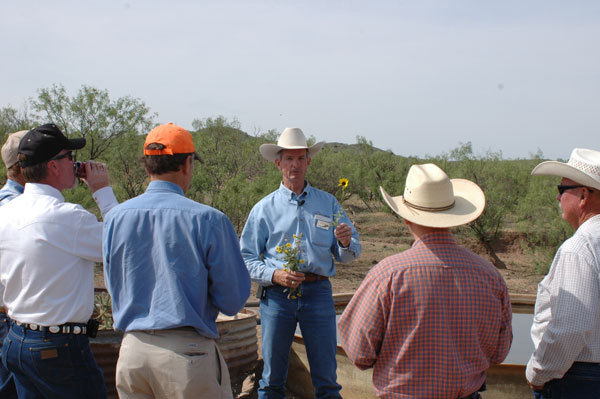Can Cattle And Wildlife Coexist?
While incorporating additional enterprises into a ranch operation isn’t a new idea, it can be attractive when trying to optimize cash flow.Watch a video interview here and browse our photo gallery here.

Drought happens. And because it does, says Ken Cearley, Texas AgriLife Extension Service wildlife specialist, it’s helpful to have some ideas in mind that can keep the income stream flowing as you cut back on cow numbers and have fewer calves to sell. (See the photo gallery here.)
One such complementary enterprise is a hunting lease. Cearley says he’s often asked if cattle and wildlife can coexist, not only in the same habitat but as complementary enterprises on a ranch. The short answer, he says, is yes. “But you need to compromise with your livestock and your wildlife to make both work together.”
There’s strong demand for places to hunt, particularly quality places, and hunting leases can fetch very attractive prices, he says. But hunters who are willing and able to pay for the privilege expect a little more from the landowner than just a key to the gate. That’s where the concessions and compromises come in, Cearley says. And he knows of what he speaks. He’s walked that path both as a rancher and as a wildlife manager.
“If livestock is your main priority, it will require some conscious effort to make sure you leave room for the wildlife,” he says. In his area of the state, the Texas Panhandle and West Texas, quail and deer are the primary species. “Not that other species aren’t important, but they’re the primary commercial species in this part of the country.”
Using quail as an example, he says it’s important to adjust your stocking rate and brush-control practices so you leave both nesting cover and brush cover. Since quail are ground birds, they need places to hide; “quail houses,” as Cearley calls them, are patches of low-growing brush located about 50 ft. apart.
“If you have 50 ft. between them, a 13-ft.-diameter quail house would only be about 5% brush cover,” he says. “So you’re not talking about a lot of brush needed for quail. If that is a 20-ft. diameter, that’s 10% brush cover.” So from a grazing perspective, you’re not giving up a whole lot, he says.
Where adjustments to stocking rate and grazing pressure come into play is in the need to leave residual bunch grasses as nesting sites. Quail are ground-nesting birds and nesting begins before the growing season.
Although quail strongly prefer bunch grass, they’ll nest in low-growing prickly pear or sage if drought has hammered the grass into submission, he adds. A good rule of thumb for a minimum amount of nesting cover for quail is 250 clumps of grasses/acre, spaced about 13-15 ft. apart –“about as far as you can throw a rope,” Cearley explains.
A different story for deer
For white-tailed deer, brush cover is a different story. White-tailed deer ideally need around 45-50% brush cover. Mule deer, being a more arid land, open space species, don’t have quite that need for protective cover, but do need adequate brush for browse.
But 50% brush cover is harder to hunt and cuts your stocking rate. “Huntability is a big part of our enterprise development when it comes to wildlife,” Cearley says. “How huntable your place is will determine how attractive it is to hunters. It would be more huntable at a lower brush density, and that would favor your cattle operation to boot. But it might not favor the deer hunting so much, so there’s a balance to be made.”
Some ranchers are concerned with diet overlap, Cearley says, thinking that deer will compete with cattle for nutrients. “Their diets do overlap,” he says, but not substantially. “Deer do eat some grass. Cows eat a lot of grass. Deer eat a lot of browse and forbs, cows eat some browse and forbs.”
But as long as there’s enough of both, there’s little overlap. “It’s like setting the table for 100 people and 150 show up,” he says. Somebody is going to be left with only half a roll and a few stray green beans. “But if you set the table for 100 and 100 show up, you’re OK.”
Where the competition comes in is when grass is short. Cows can eat browse and forbs if necessary, whereas deer can’t switch and use grass as a major part of their diet, he says.
“That’s why grass and brush management is so important,” he says. “You need grass for your cows and residual grass for the quail. You need less impact on the forbs and browse from the cows so you’re not creating competition for the deer. Having a grazing management program that supplies you with enough grass will prevent you from doing that.”
About the Author(s)
You May Also Like



